


Italy Through Fresh Eyes: Chasing the Sun in Italy in March - Part 3 Rome
Thursday, March 23, 2017 - Rome
We ended up getting to the train station almost an hour before our train to Rome so we sat and had cappuccinos at a train station café listening to people play the piano. I love that many train stations in Europe have pianos just sitting there waiting for passersby to stop and play a few tunes. In the hour we were there several people did just that.
Train was high speed (up to 255km/hr) and took just 1.5 hours. Went through a lot of tunnels – ear popping. Somehow I booked us in Business Class – seats are a bit wider, and leather instead of cloth. Otherwise no difference and certainly not worth any extra money.
Checked into the Hotel Julia. It’s almost a half hour walk from Termini. It’s twice as far as the Floris, the other hotel I’ve stayed at recently in Rome, but they were full with only two days notice. So it was a pain to drag the bags, but once at the Julia it is closer to everything. A ten minute walk to the Trevi Fountain, less than five minutes to Piazza Barberini (where there is a metro stop), and on a quiet (for Rome) street. It's a perfectly fine hotel, not luxury but clean and comfortable. There is an annex next to the main building, where the rooms are a bit nicer, but the wi-fi not as good (at least it wasn't a few years ago, it was great in the main building this trip).
As we had not planned on going to Rome on this trip I had none of my information with me, no map (although the hotel has good free maps they give out). Fortunately I’ve been there enough recently that I know my way around pretty well. I took Crista on my favorite “Introductory Rome Tour” (the center of Rome is a UNESCO World Heritage Site)
Trevi Fountain (nice and clean after it’s recent renovation, the scaffolding that’s been in place the last few years all gone), The Trevi Fountain, 1762, is an incredible Baroque Masterpiece, huge and beautiful. But it's beauty and fame (featured in "Three Coins in a Fountain", the 1954 film that was the first color film to be produced on location, it made half of America decide to go visit Italy) have caused it to be difficult to visit. An aquatic marvel in a city filled with them, the fountain's unique drama is largely due to the site: its vast basin is squeezed into the tight meeting of three little streets (the "tre via", which gives the fountain its name) with cascades emerging as if from the back wall of Palazzo Poli behind it. The tiny piazza in front of it is literally jam-packed most of day, full of tourists trying to throw a coin over their shoulder into the fountain to assure they will return to Rome. There are some railings to lean on - if you can get anywhere close to them - but no benches. Early in the morning before the tour groups arrive it is still enjoyable, after that forget it.
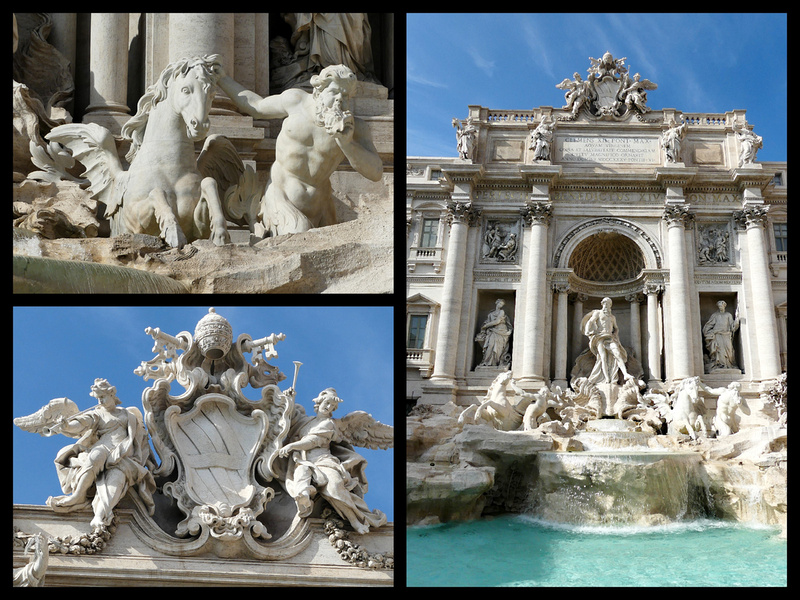

Piazza Colona (site of one of the most dramatic obelisks in Rome, the Column of Marcus Aurelius built in AD180 but changed in 1589 when a pope replaced the Roman warrior on top with a statue of St Paul. Behind the obelisk is the Palazzo Chigi, residence of the prime minister.) Then on to Piazza di Montecitorio – a Bernini designed piazza containing a 6th century BC Egyptian obelisk. About a block further is La Maddalena, Rome’s only truly Rococo church, 1669. Slight detour back a block or so to Piazza di Pietra home to 11 huge Corinthian columns that are the remains of the 2nd Century Tempio di Adriano.
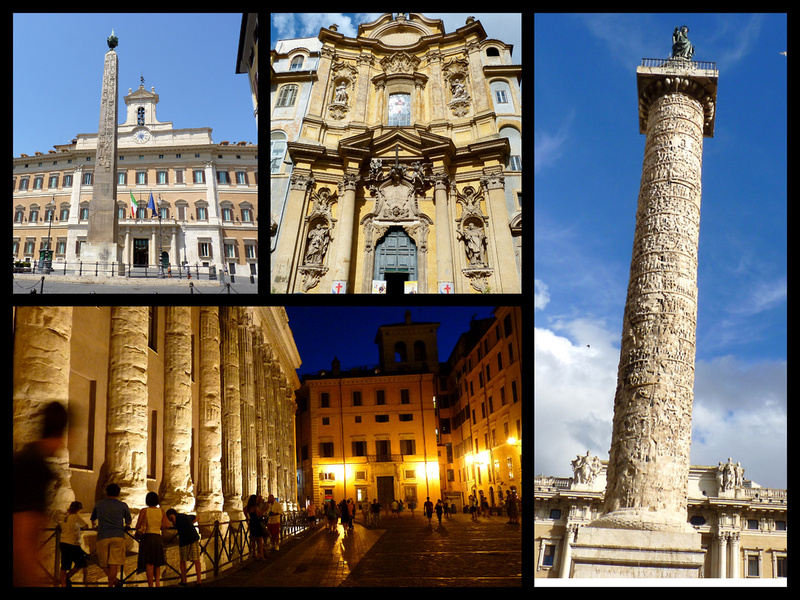
 Clockwise from upper Left: Piazza di Montecitorio, La Maddalena, Column of Marcus Aurelius, Piazza di Pietra
Clockwise from upper Left: Piazza di Montecitorio, La Maddalena, Column of Marcus Aurelius, Piazza di Pietra
Another block or two to Piazza Rotunda.


Piazza Rotunda is one of my favorite piazzas in Rome but it was soooo crowded and a line to get into the Pantheon! (it’s free, the line was just too many people trying to get in). Six previous trips to Rome, many of which were in high season and I never saw it like this. So we skipped going in for the time being. At 9:00 the next morning there was no line and virtually empty inside. In the center of the piazza is my favorite fountain, the Fontana del Pantheon, 1575, surmounted by an Egyptian obelisk.


The Pantheon is the best preserved ancient monument in Rome. A pagan temple originally dedicated to 'all the gods' it was transformed into a church in AD 609. Originally erected by Agrippa in 27BC, (you can still see letters engraved on it spelling Agrippa) it was rebuilt by emperor Hadrian in AD120. It's size is immense but more impressive is the harmony - the diameter of the dome is exactly equal to its height - some people call it the world's most architecturally perfect building. The opening in the center of the dome is 30 feet in diameter, the temple's only source of light, intended to symbolize the 'all-seeing eye of heaven'. It houses the tombs of the artist Raphael and the first king of Italy, Vittorio Emanuele II.
Just behind the Pantheon is the Chiesa di Santa Maria Sopra Minerva, a church built over (sopra) an ancient temple (of Minerva). The church has been ‘renovated’ numerous times so it’s not terribly authentic despite technically being Rome’s only Gothic church. But inside is a Michelangelo sculpture and outside is an adorable elephant sculpture atop a short obelisk, by Bernini. Free


Elephant statue in Front of Santa Maria Sopra Minerva, Back of the Panetheon
On to Piazza Navonna – [So far this is only about .8 mile] Rome’s most impressive Baroque square. The piazza’s long narrow shape is because it was built over space formerly used for chariot races. At center is the Fontana dei Quattro Fiumi, [Fountain of the Four Rivers] built by Bernini in 1651. The figures of the four rivers represent the four known continents as of 1650: the Nile; the Ganges (holding an oar); the Danube (looking at the obelisk); and the Plata (from Uruguay, tumbling backward), with its hand raised. The figure of the Nile is hiding its head because it represents a river whose source was then unknown. At the south end is the Fountain of the Moor (Fontana del Moro), also by Bernini. At the north end of the square is The Fountain of Neptune (Fontana di Nettuno), a 19th Century addition.
Crista duly impressed, not only with all the sculptures and fountains, but also the beautiful Sant’Agnese in Agone church, and just the overall ambiance of all the ochre colored buildings, cafes, artists selling their work. So far we have seen enough sculptures, fountains, etc. to fill a museum, but all of it for free, in the places for which they were designed.


We then wound our way through the narrow streets and tiny Piazzettas towards the Tiber (one of my favorites is Piazzetta di S Simone)


and up to Piazza del Popolo, one of Rome’s largest squares which was gorgeous in the late afternoon sun with blue sky and puffy white clouds. [another approximately 1 mile]. In the center is an Egyptian obelisk from the 13th C, brought to Rome during the reign of Augustus, surrounded by four of my favorite lion fountains. Surrounding the square are other statues and fountains. At one end is a pair of twin churches, Santa Maria del Miracoli and Santa Maria di Montesanto. At the other is another church, Santa Maria del Popolo (1442-47, Renaissance) and Porta del Popolo, the gateway in the 3rd C Aurelian wall. The gate was erected in 1561, and was one of the major gateways into the city.

 We climbed the Rampa del Pincio from Piazza del Popolo to the Pincio Terrace, in the Borghese Gardens. There is a spectacular view of the city from here. Everything was that gorgeous spring green color, there was wisteria, forsythia, and pink and white and purple flowering trees.
We climbed the Rampa del Pincio from Piazza del Popolo to the Pincio Terrace, in the Borghese Gardens. There is a spectacular view of the city from here. Everything was that gorgeous spring green color, there was wisteria, forsythia, and pink and white and purple flowering trees.
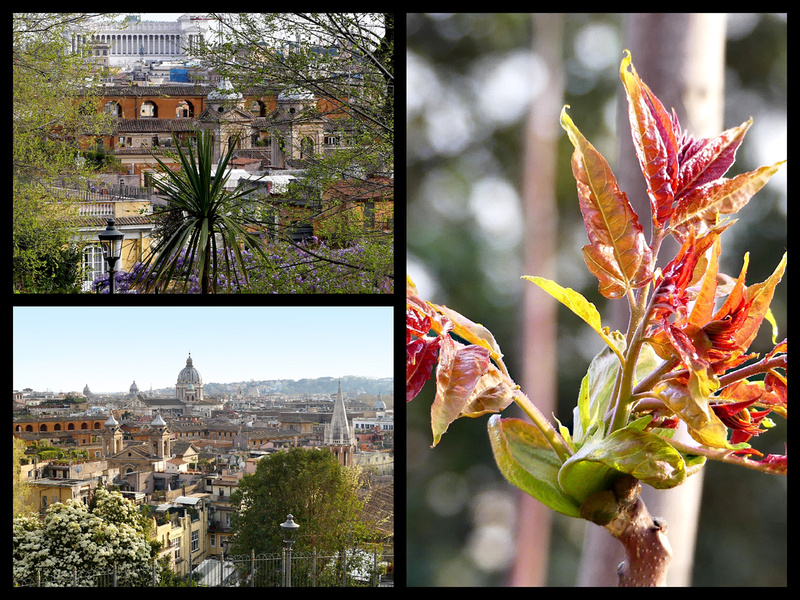

About a half a mile from there brings you to the top of the Spanish Steps. Guidebooks say the Spanish Steps are ‘one of the most famous images’ in the world, certainly it’s well featured in tons of books and movies but Crista managed to have never heard of it. Still, she managed to be impressed by it.


It is one of the most majestic urban monuments of Roman Baroque style. Designed in 1723, the Spanish steps (there are 135 of them) were funded by the French as a preface to the French church, Trinità dei Monti at the top of them. It was given the name Spanish Steps because the Spanish Ambassador lived at the bottom, in the Piazza di Spagna. It has long been one of the most popular tourist attractions in the city: attracting artists and writers and was full of elegant hotels. At the foot of the stairs, is the Barcaccia Fountain, the work of Bernini who went on to become the creator of some of the most important masterpieces of Baroque art in the city. In the form of a sinking ship, the fountain recalls the historic flood of the River Tiber in 1598 and refers to a folk legend whereby a fishing boat carried away by the flood of the river was found at this exact spot. In reality, the sinking boat was ably invented by Bernini to overcome a technical problem due to low water pressure. The sun and bee ornamentation is a symbol of the Barberini family and a reference to Pope Urban VIII who commissioned the work. The staircase is an architectural feat with its ramps and stairs that intersect and open out like a fan definitively providing a solution for connecting the square and the Trinità Church above.
Via Sistina is just a busy shopping street although I love the view of the bell tower of Santa Maria Maggiore in the distance. At the end of the street is Piazza Barberini, with the 1642 Triton Fountain (Fontana del Tritone) in the center. Another baroque masterpiece by Bernini ( as well as the Palazzo Barberini a block down the street), it features four dolphins holding up an open scallop shell in which a triton sits blowing into a conch.
Piazza Barberini is only about a tenth of a mile from our hotel, on via Rasella. So this whole walk is really only about 3 miles – although with little detours and such it took us considerably more (according to my fitbit).
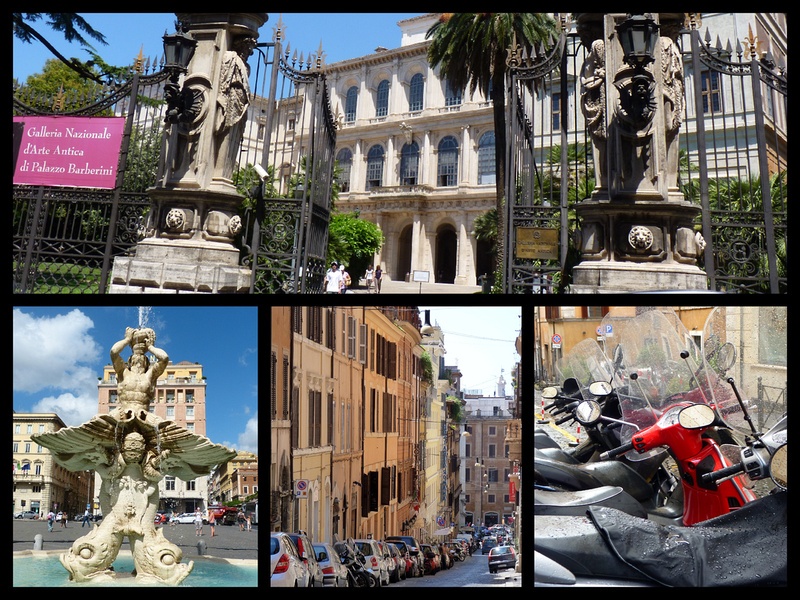

We had dinner at a restaurant on Piazza Barberini, got a bottle of wine and went back to the hotel.
Friday, March 24, 2017 - [Mostly sunny, 75] - We repeated the beginning of yesterday’s walk, this time getting to the Pantheon before the crowds. But from Piazza Navona we went in the other direction to Campo di Fiori.
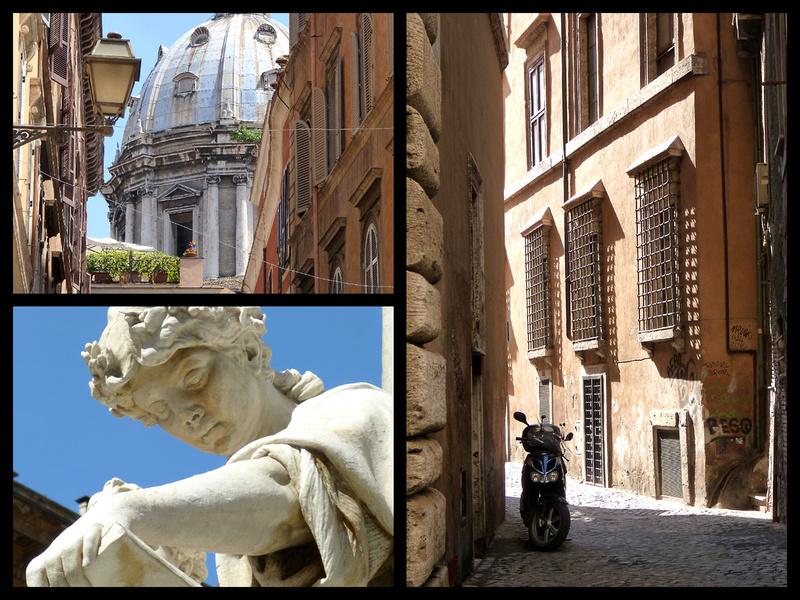
 Streets in the area between Piazza Navona and Campo di Fiori
Streets in the area between Piazza Navona and Campo di Fiori
In ancient times the square was used as grazing land for cattle, hence the name, which means field of flowers. In those days buildings stood on one side of the square only, with a view over the Tiber on the other. During the 1500s, this square was the geographic and cultural center of secular Rome, with inns and the occasional burning at the stake of religious heretics. The hooded statue in the center is of a philosopher burned at the stake here in 1600. Today the campo hosts a morning open-air food market (Mon.-Sat. 8 AM-1 PM), Except for the pizzerias and gelaterias, it still looks much as it did in the early 1800s.


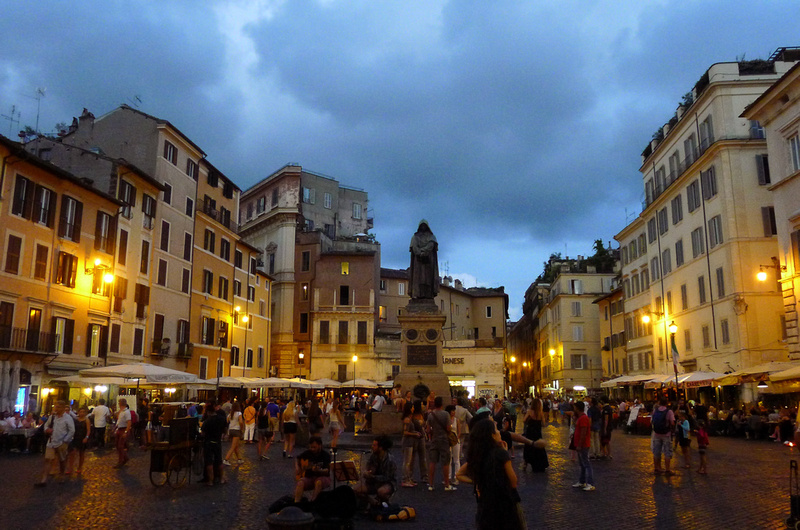

Next we stopped at the Torre Argentina / ‘Area Sacra’, site of the remains of four temples from 200-300 BC. A cat sanctuary, run by volunteers is in one corner and cats roam the area.


A few blocks further on is Piazza Venezia, sort of the central ‘hub’ of Rome – a very busy, traffic filled square in front of the Vittorio Emanule II Monument. The monument, to the first king of Italy (I think there is a monument and/or street named after him in absolutely every town in Italy) is a huge white building, with an enormous flight of stairs leading up to it. Totally covered in statues, and fountains and columns. Inside the building are museums, but on both sides are terraces with great views in all directions and those are free.


Across the street is Trajan’s Column sitting at the beginning of the Via dei Fori Imperiali. Mussolini cut through centuries of debris and junky buildings to reveal many archaeological treasures and carve out this boulevard linking Piazza Venezia to the Colosseum. The vistas over the ruins of Rome's Imperial Forums from the northern side of the street and the Roman Forum on the south side make this half mile one of the most fascinating walks in Rome. And it's mostly pedestrianized.
Begun by Julius Caesar as an answer to the overcrowding of Rome's older forums during the days of the empire, the Imperial Forums were, at the time of their construction, flashier, bolder, and more impressive than the old Roman Forum, and represented the unquestioned authority of the Roman emperors at the height of their absolute power. A good section of The “Roman Forum” can also be viewed from this street, and recently signs have been erected telling people what they’re looking at, and with drawings showing what the ruins would have looked like. The Roman Forum was the center of life in Rome, evidenced by the many remains of triumphal arches, temples and basilicas. Although fascinating just to look at, having a map or guidebook telling you what each ruin was is a good idea, although the new signs really do help. You also get a different feeling and perspective from walking around in the Forum and from viewing it from above (both on this street, and even better from behind Capitoline Hill).
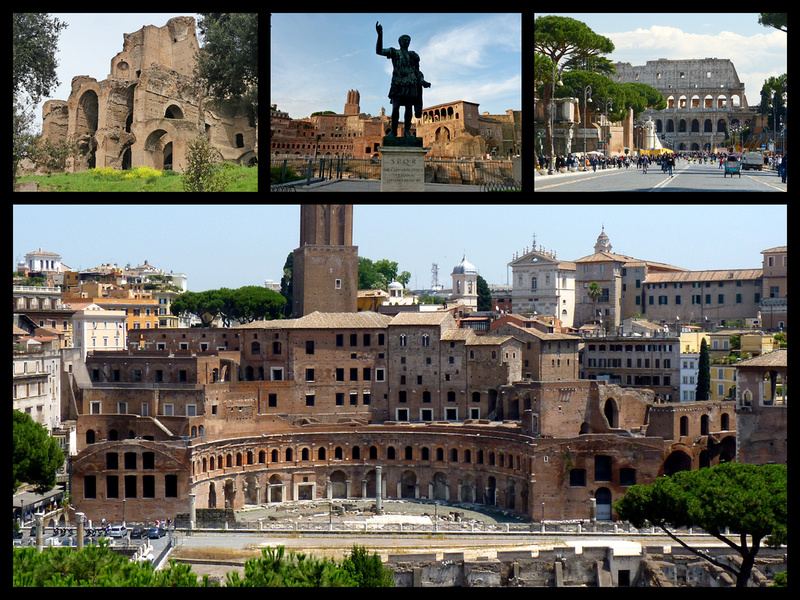
 Back of Palatine Hill, the Imperial Forum from Via dei Fori Imperiali
Back of Palatine Hill, the Imperial Forum from Via dei Fori Imperiali
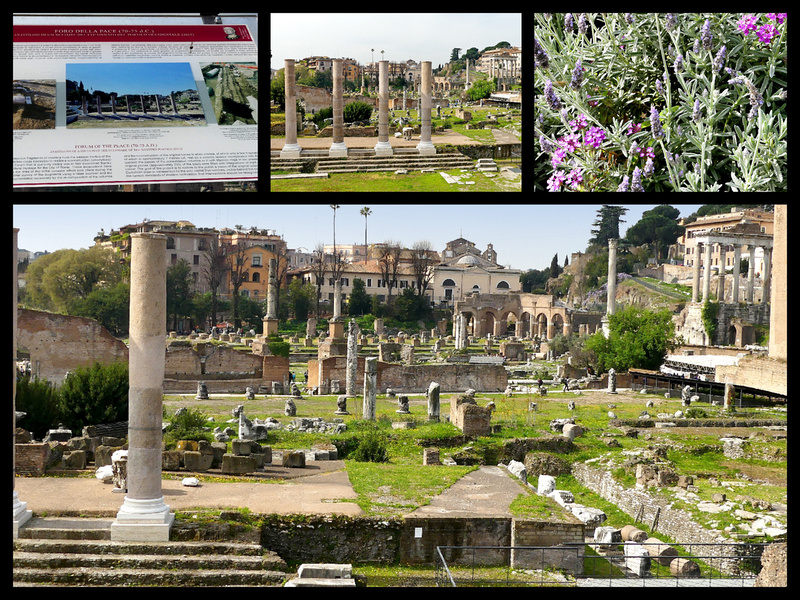
 The Roman Forum as seen from via dei Fori Imperiali
The Roman Forum as seen from via dei Fori Imperiali
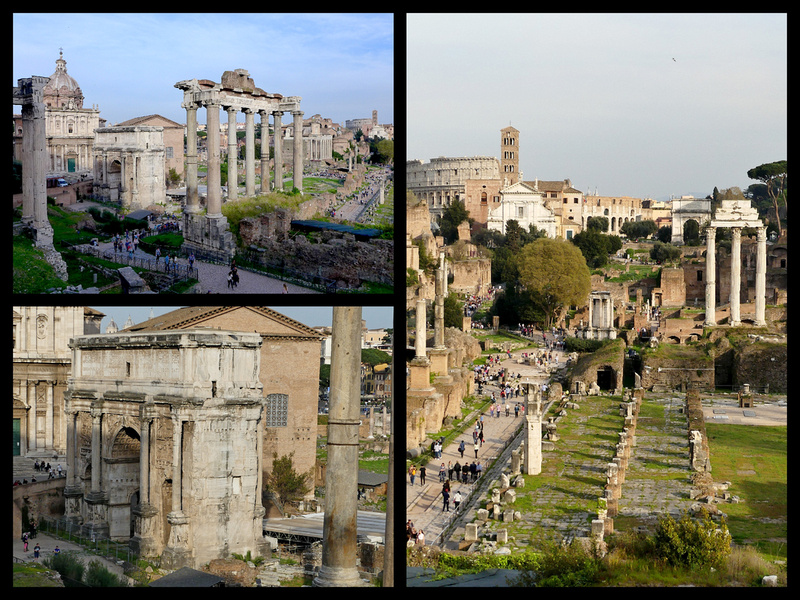
 The Roman Forum as seen from behind Capitoline Hill
The Roman Forum as seen from behind Capitoline Hill
The Colosseum sits at the end of Via dei Fori Imperiali. The huge amphitheater was built on the site of an artificial lake, part of Nero's huge park in the center of Rome which also included the Golden House (Domus Aurea) and the nearby Colossus statue. This giant statue of Nero gave the building its current name. The Colosseum is gigantic and from pictures of it’s original appearance, clad in marble and covered with statues, it was really impressive. Especially from the outside. But it’s still really impressive even though most of the statues and marble were stolen over the centuries to build Renaissance era churches and palaces. Not that the inside isn’t also really interesting, but if time is limited, walking around the outside I think is better.
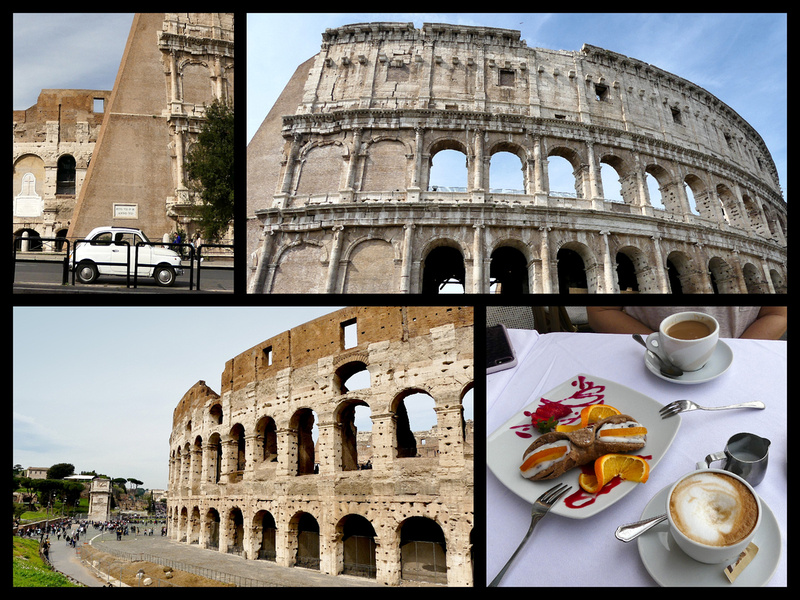

The Colosseum was the place of the grossest and best-organized perversity in all history. Gladiatorial contests were designed to make Romans better soldiers by rendering them indifferent to the sight of death. Exotic animals were shipped in from the far corners of the empire to satisfy jaded tastes (lion versus bear, 2 humans vs. hippopotamus). Not-so-mock naval battles were staged (the canopied Colosseum could be flooded), and the defeated combatants might have their lives spared if they put up a good fight. Many historians now believe that one of the most enduring legends about the Colosseum (that Christians were fed to the lions) is unfounded.
Tickets (which include the Forum, the Colosseum and Palatine Hill) can be bought at any of the three, and lines are always shorter at the other two. Even with a ticket, lines to get into the Colosseum can be crazy. We walked all the way around the Colosseum which I recommend. It really does look different from the ‘back’ as well as the ‘front’.
We stopped for cappuccinos and a snack at a café – horribly overpriced but worth it for the view.
Between the Colosseum and Palatine Hill, the biggest of the triumphal arches, the Arch of Constantine, 315 AD, spans the via Triumphalis, the way taken by the emperors when they entered the city in triumph. Today it’s lined with tour buses. We walked all the way down and around to the back of Palatine Hill through the Circus Maximus which was where chariot races were held. Today it just looks like an empty park. But seeing the Palatine Hill from the different angles is interesting. Palatine Hill is the center-most of the Seven Hills of Rome and is the ancient most part of the city. Imperial palaces were built here and it is from the name “Palatine” that the word palace/palazzo come from. It was on the Palatine Hill that Rome first became a city. Legend tells us that the date was 753 B.C. The new city originally consisted of nothing more than the Palatine, which was soon enclosed by a surprisingly sophisticated wall, remains of which can still be seen on the Circus Maximus side of the hill.
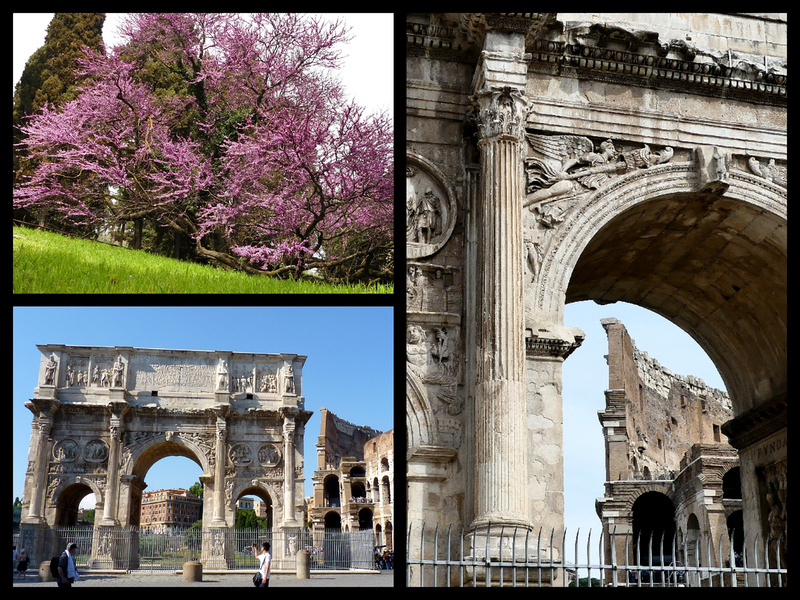

At the far end of Circus Maximus is the Church of Santa Maria in Cosmedin, with a Romanesque campanile (11th century), best known as the home of the “Mouth of Truth” (bocca della Verita), made famous in the movie “Roman Holiday” where Gregory Peck demonstrates to Audrey Hepburn that the mouth is supposed to chomp down on the hands of liars who insert their hands. Ninety percent of the tourists who come here stand in the long line to get their photo taken and never even venture into the church, one of the most unusual in Rome. The church, with a haunting, almost exotic interior is free, and for €2 you can go down into the crypt which is even more intriguing. Outside, on the Piazza della Bocca della Verita are two Roman era temples, the Temple of Hercules Victor (the round one) and the Temple of Portunus, a diety related to the ancient river harbor just across the street. There’s also the Fountain of the Tritons (1715) and around the corner from this piazza is another large arch, the Arch of Janus.
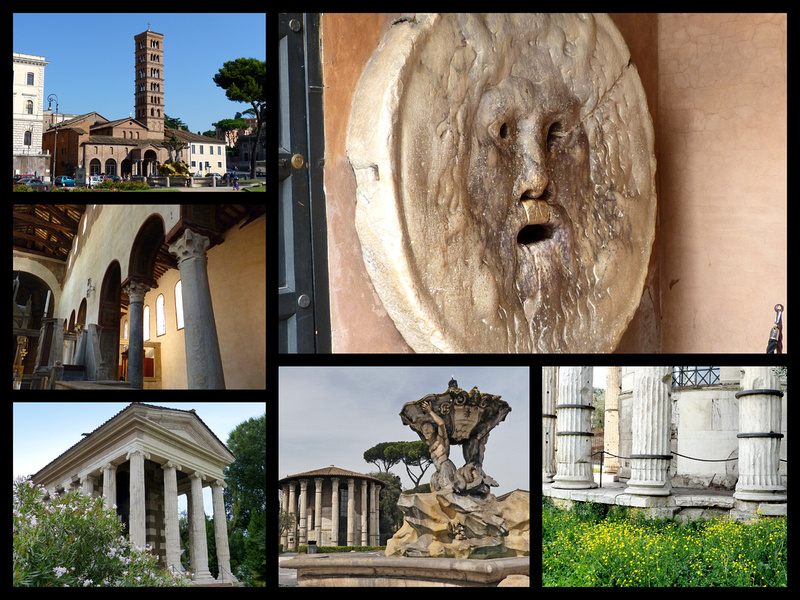

From the Piazza della Bocca della Verita we detoured across the street to have a look at Isola Tiberina (the island in the Tiber). The oldest bridge in Rome, the Ponte Fabricio (62 BC) connects the island to the Tiber’s eastern bank. The island is associated with the healing powers of the god Aesculapius, son of Apollo. Legend has it that in the 3rd C BC the Romans sent a boat to Epidaurus in Greece to discover a cure for the plague. On the return trip Esculapio left the ship in the shape of a serpent and swam to the island, indicating that a temple to the god of healing should be built here. The church of San Bartolomeo was built on the site. In the 1st C BC the Romans reshaped the island with slabs of travertine to form a “prow”.
Continuing on to Via del Teatro di Marcello you pass by the church of San Nicola in Carcere (St Nicolas in Prison), a typical example of Roman 11th C construction which was built within the ruins of three republican era temples. The temples were dedicated to the two-face god Janus, the goddess Juno and to the god Spes (hope). These Temples once overlooked the city of Rome’s fruit and vegetable market. The columns that once held these temples up can still be found embedded into the walls of the church and are easily seen just by walking by. This church also has a crypt that you can go down into, although we didn’t do that this trip.)
Another block or so is Teatro di Marcello, a small corner of the 2000 year old arcade has been restored to what presumably was the original look. Next to it are three Columns of Apollo and a smattering of other, smaller ruins.


Another block or so brings you to the base of the steps leading up to Capitoline Hill (Campidogilo), the most sacred of Rome’s seven hills. It was once the epicenter of the Roman Empire. The city's archives were kept in the Tabularium (hall of records), the tall tufa structure that forms the foundation of today's city hall, the Palazzo Senatorio, which features a classic Renaissance Italian bell tower and double sided staircase.
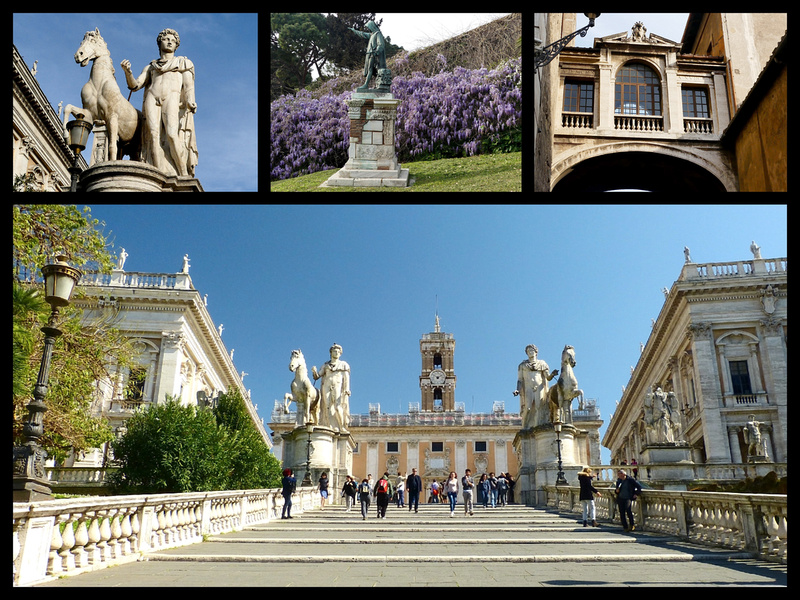

Michelangelo created the piazza with it’s slightly convex pavement, the staircase ramp, the buildings and facades on three sides, and the pedestal for the bronze equestrian statue of Marcus Aurelius. On the other two sides of the piazza, Palazzo dei Conservatori and Palazzo Nuoveo, have been incorporated into the Capitoline Museums, one of the oldest museums in the world. These museums house some of the greatest pieces of classical sculpture in the world including the renowned symbol of Rome, the Capitoline Wolf, a 6th C BC Etruscan bronze (the suckling twins were added during the Renaissance to adapt the statue to the legend of Romulus and Remus – there is a copy outside). As Michelangelo's preeminent urban set piece, the piazza sums up all the majesty of High Renaissance Rome. From behind the Palazzo Senatorio, a stairway leads down, offering the best overview of the roman Forum. The front of the piazza looks out over the Piazza Venezia.
The loop I just described (from Piazza Venezia and back) is about three miles (plus detours of course). From the Hotel and back we walked about six miles.
After a bit of siesta at the hotel, we headed to St Peter’s. The first stop was Ponte Sant'Angelo, pedestrianized and lined with ten stone angels it joins ‘the heart of Rome’ with the Vatican side and leads directly to Castel Sant'Angelo.
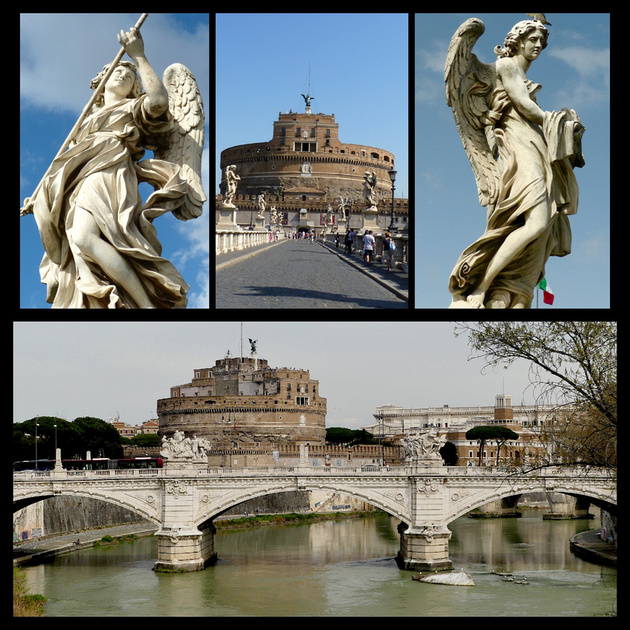

Castel Sant’Angelo - During its many years of existence, the building functioned as a mausoleum, became part of the city wall and later was turned into a fortress before it functioned as a papal residence and finally as a barracks and military prison. Emperor Hadrian chose this spot away from the city’s main area as the site for his tomb. From the top is one of the best views of Rome. The castle houses part of the Museo Nzionale Romano. In AD 590 Rome was stricken with the plague and Pope Gregory organized a procession to pray for the city’s release. As a result of the miracle the building was renamed Castel Sant’Angelo. In the 9th C it was linked to the nearby Vatican by building a high defensive wall. The spiral ramp inside the castle dates back to the time Hadrian’s mausoleum and part of it can still be climbed to the main courtyard where the statue of Archangel Michael, 1544, stands. There is another Archangel Michael, 18th C, at the top of the terrace along with the Bell of Mercy which in the past pealed to announce executions. The moats and gardens are a 20th Century addition.
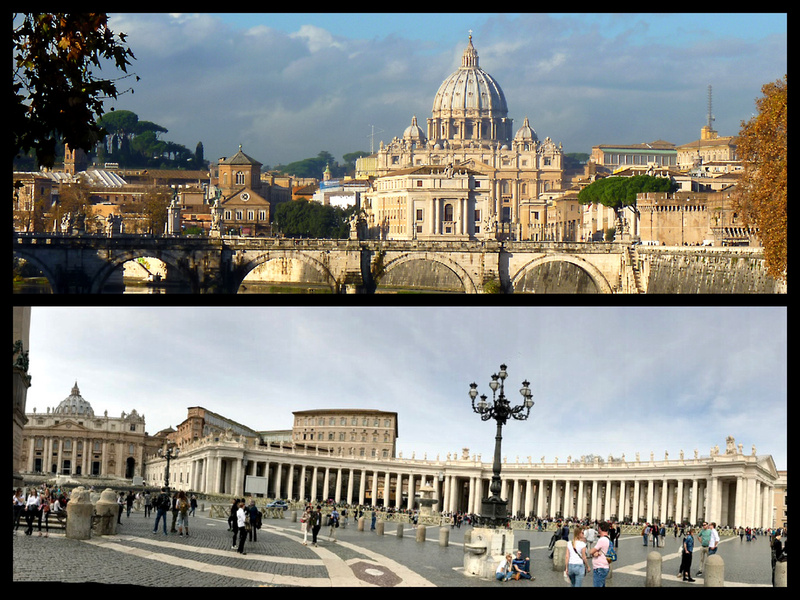

St Peter’s Basilica looks close from Castel Sant’Angelo but it’s actually more than half a mile. Piazza San Pietro is huge, with a massive Egyptian obelisk supported by bronze lions and two fountains in the center and surrounded by the ‘Tuscan Colonnades’, four columns deep which curve around the sides of the square from the Basilica. Bernini designed the piazza and the colonnades to be “the maternal arms of the mother church”. The whole ensemble is gorgeous and a definite ‘must see’ even if you have no interest in the catholic religion. The place is packed with tourists most of the day, some just taking it all in, the rest waiting in the long security line to get into the church. Given our limited time on this trip we didn’t go in but it is a really amazing space and worth the hour or so wait on line. Around the side of the piazza is the city wall, through which a gate leads to the entrance to the Vatican Museums (which always has an enormous line – every time I’ve been there – July, March, November, early in the morning, mid day, rain, shine).
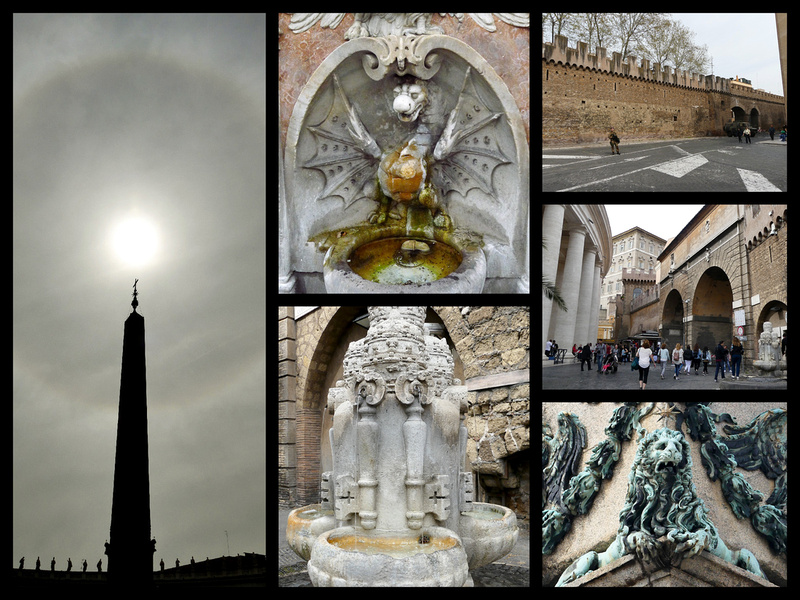

We took the Metro back, got a pizza to eat in room and took a short siesta before heading out for a drink and to see Rome lit up. The Piazzas are all beautifully lit – my favorite for evening ambiance are Trevi (if the crowds aren’t too bad), Rotunda and Narvona. We started the evening with a drink near Piazza di Pietra, strolled around the streets and piazzas as the sky turned dark blue and the buildings became beautifully gold colored, and finished the evening with a gelato at a café in Piazza Rotunda next to my favorite site in Rome – the Fontana della Rotunda backed by the Pantheon.
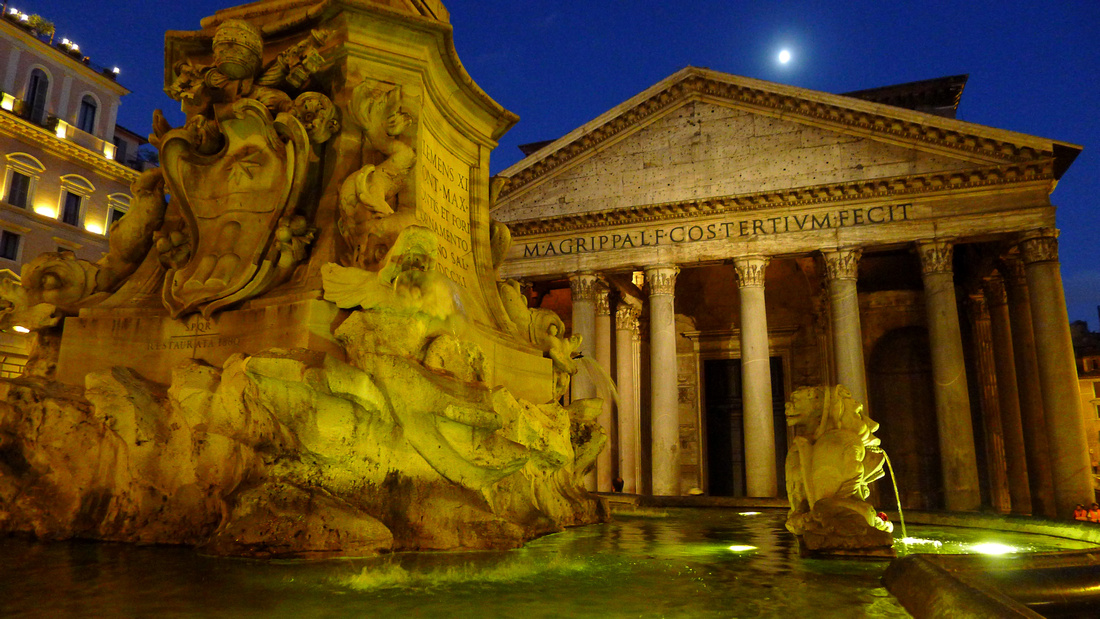

Saturday, March 25, 2017 [Sunny and 78] – Not a cloud in the sky. Best day yet and we had nothing really to do. We had condensed what we planned to do in two full days down to a day and a half since we discovered that there were demonstrations planned in Rome for the 60th anniversary of the European Union so stores were to be closed and they made it sound like pedestrian access to the center was going to be curtailed - they were expecting possible violence. We tried to get our train tickets changed to an earlier one but couldn’t (special price). So we went to S. Maria Maggiore (with our bags) and took turns going in and sitting in the sun. Then went to a café and sat in the sun there and age gelato. Had lunch at the train station, then comfortable 3-hour train trip to Milan.
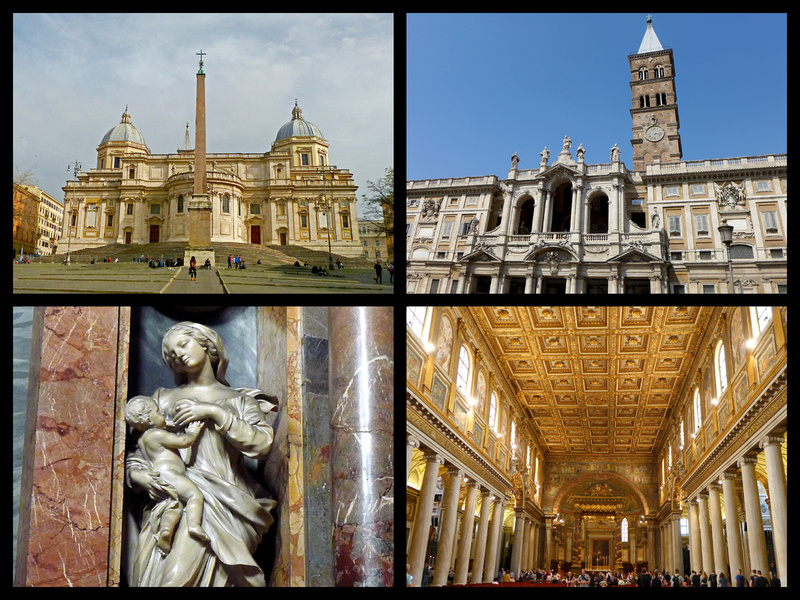

For the Venice, Florence, and Milan portions of our trip see parts 1, 2, and 4 of "Italy through new eyes: Chasing the Sun in Italy in March"
For more photos click on "All Photographs in the upper right corner and navigate to the Italy gallery.